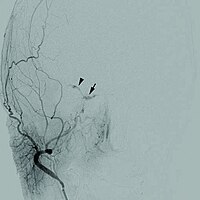
Photo from wikipedia
Moyamoya disease (MMD) is a chronic, progressive cerebrovascular disease involving the occlusion or stenosis of the terminal portion of the internal carotid artery (ICA) and the proximal anterior and middle… Click to show full abstract
Moyamoya disease (MMD) is a chronic, progressive cerebrovascular disease involving the occlusion or stenosis of the terminal portion of the internal carotid artery (ICA) and the proximal anterior and middle cerebral arteries. Adults with MMD have been shown to progressively accumulate neurological and cognitive deficits without treatment, with a mortality rate double that of pediatric patients with MMD. Surgical intervention is the mainstay of treatment to prevent disease progression and improve clinical outcomes. Several different types of bypasses can be utilized for revascularization in MMD, including indirect, direct, and combined forms of extracranial-to-intracranial (EC-IC) bypass. Overall, the choice of appropriate technique requires consideration of the age of the patient, preoperative hemodynamics, neurologic status, and territories most at risk and in need of revascularization. Here, we will review the indications and surgical techniques for the treatment of adult MMD. Step-by-step instructions for performing several bypass variants with technical pearls are discussed.
Journal Title: Frontiers in Surgery
Year Published: 2022
Link to full text (if available)
Share on Social Media: Sign Up to like & get
recommendations!